Trips on the island of Zakynthos
The Ionian island of Zakynthos is an ideal destination for an active seaside holiday. The island with its coastline of limestone cliffs, golden sandy beaches and natural blue caves attracts tourists especially for boat trips, swimming in the beautiful bays and exploring the diverse flora and fauna.
Among the most popular excursions are the cruise to Navagio Bay, complete with the famous legend of the shipwreck of the smuggler's ship, boat trips to the so-called blue caves, where the sun's rays play with the azure colour of the sea, or boat trips involving swimming and watching the protected Caretta-Caretta turtles.
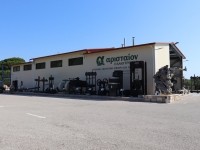
Aristeon Press and Museum
Olive Paradise Lithakia

Askos Stone Park
Stone Park Askos (Agios Nikolaos)
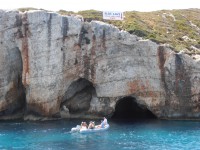
Blue Caves
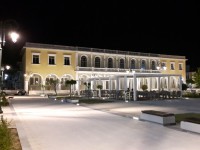
Byzantine Museum
Museum of Zakynthos
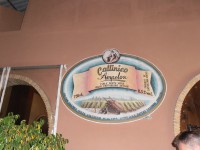
Callinico Winery
Combination of delicious wine and tradition
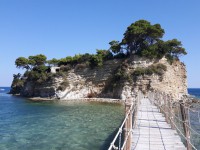
Cameo Island
Island of Agios Sostis
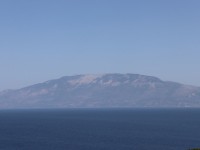
Kefalonia island
Keri Caves
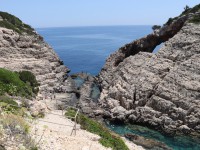
Korakonissi
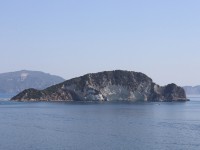
Marathonisi (Turtle Island)
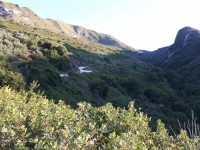
Mount Skopos

Olympia
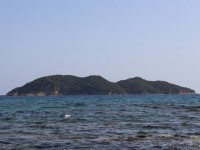
Pelouzo Island
Kalonisi Island
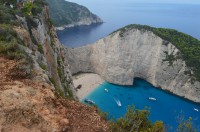
Shipwreck (Navagio Beach)
Shipwreck Beach, Navagio Bay, Smugglers Cove
Strofades Islands
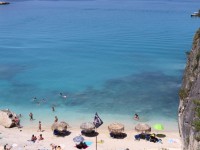
Sulfur beach Xigia
Natural baths of Zakynthos island
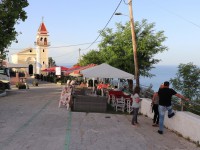
Viewpoint Bochali
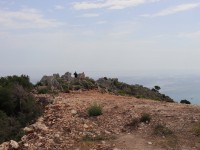
Viewpoint Pikas
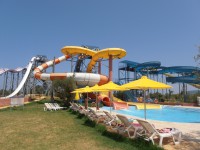
Water Park Zante Water Village (Sarakinado)
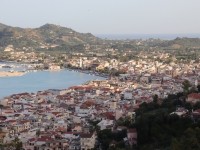
Zakynthos Capital City
Boat trips around the coast of Zakynthos
Zakynthos boasts a beautiful lush nature and a diverse coastline of approximately 123 km. The southern and eastern coasts of the island are dominated by beautiful sandy beaches with a gentle entrance to the sea, often accompanied by beach services and water sports, making them ideal for typical holiday lounging, swimming and adrenaline-pumping water activities. The most popular beaches on the island are Laganas beach, Porto Azzuro beach, Banana beach, Tsilivi beach, Gerakas beach and others.
The northeastern and especially the western coasts of Zakynthos are much more interesting in terms of boat trips, as they are mostly rocky with various coves, caves and rock overhangs. The Ionian Sea becomes incredibly clear and azure blue along these shores. Zakynthos is also an excellent destination for diving enthusiasts, who rank it among several of the best diving sites in Europe.
Navagio Beach with a shipwreck - The beach lies in a cove off the northwest coast of the island, protected by high cliffs and, especially from a distance, a truly breathtaking view. The beach is covered with small white pebbles and together with the azure sea it creates a beautiful colour contrast, which is further enhanced by the old wreck of a smuggler's ship right in the middle of the beach. The beach is only accessible from the sea (unfortunately, it was closed to the public in 2023 due to rockslides), but you can also enjoy the view from the cliffs above, where a small lookout has been built.
Blue Caves - These caves are made up of light limestone and with good reflection of the sun's rays, the water in the caves really glows azure blue. The most beautiful blue caves are in the northern part of the island, near the villages of Agios Nikolaos and Volimes, and are only accessible by boat. Some excursions also include swimming in the caves and snorkelling. If you sail around the northern tip of the island, you can also enjoy the view of Skinari Lighthouse.
Korakonissi - Korakonissi is a rock formation that resembles a small island, although it is connected to the mainland. What makes it unusual is the large rock arch and the small lakes that have naturally formed on the rocky shoreline. It is located in the south-western part of the island, near the village of Kiliomenos.
Keri Caves - Off the southern tip of Zakynthos are the beautiful and rugged Keri Caves, whose nearby surroundings are ideal for diving and snorkelling.
Xigia Sulphur Beach - Off the north-east coast of the island, we can enjoy another attraction of Zante, the natural sulphur "baths" of Xigia. There are several beaches with sulphur vents in the sea, which are supposed to have beneficial effects on the human body.
Zakynthos and nearby islets and islands
The Greek island of Zakynthos is one of the few areas in the world where the rare Caretta-Caretta turtle can still be seen. The home of the giant carta is the Mediterranean Sea, and every year during the nesting season the females come to Laganas Bay to lay their eggs in the sand. Interestingly, the turtle always returns to the same beach where it was born. That's why protecting the beaches of Laganas Bay is so important.
The island is home to the Zakynthos National Marine Park, whose main task is to protect the natural heritage of Zakynthos and the endangered species that live there. Among the most endangered are the Caretta Caretta turtle and the Monachus Monachus seal. The protection zone covers the area of the southern coast of the island from Cape Marathia to Gerakas beach, including Limni Keri, Laganas and Kalamaki beaches, as well as several smaller islands located in Laganas Bay, including the islets of Marathonisi, Pelouzo, and the two small islands of Strofades, located south of Zakynthos.
The largest harbour is located in the capital of Zakynthos, from where a large number of boats and ferries depart daily during the main summer season. Navagio Bay and the blue caves are most often reached from Porto Vromi and Agios Nikolaos, but smaller boats and barges can be found from almost anywhere, for example, several are usually moored at Laganas beach. Special glass-bottomed boats are often used for giant tortoise watching trips.
Marathonisi "turtle" island - Right in the bay of Laganas is a small exotic island covered with dense greenery and with a beautiful golden beach, which is used by Caretta turtles to lay their eggs. The island of Marathonisi is a protected area and around its shores we can spot not only the giant harbour seal but also the endangered Mediterranean harbour seal.
Pelouzo Island - The small uninhabited island of Pelouzo (or Kalonisi) is also in the Gulf of Laganas and serves as a sanctuary for Caretta Caretta turtles and Monachus Monachus seals. Due to the high level of protection for the endangered species, the island is off-limits to motorized boats and visitors must be quiet and respectful on the island.
Strofades Islands - The two islands collectively known as the Strofades lie to the south of Zakynthos and are sometimes referred to as the 'floating islands' due to their flat shape. Due to the abundance of birdlife, the islands are also part of the Zakynthos National Marine Park, and especially in spring, the islands become a haven for thousands of migratory birds that pass through.
Cameo Island - Cameo is a small island off the coast of Laganas, connected to the mainland by a narrow wooden bridge. Located in the resort of Agios Sostis, the island has two bars and a nice little beach, perfect for a relaxing afternoon.
Kefalonia Island - North of Zakynthos, about an hour and a half by ferry, lies another beautiful Greek island, Kefalonia. Kefalonia is known for its beautiful nature, clean beaches and the contrast of deep caves and towering mountains. The capital Argostoli, the stalactite cave of Drogarati or the impressive monastery of Saint Gerassimos are certainly worth a visit.
Olympia - And if Zakynthos is already too small for you, a visit to mainland Greece and the vast archaeological site of Olympia, linked to the long tradition of the Olympic Games, is also an interesting trip tip. The ferry ride from Zakynthos to the Peloponnese takes about 2 hours.
Inland Zakynthos
The island of Zakynthos covers an area of about 410 km2 with a maximum land length of about 40 km and is geographically quite diverse. While the northern and north-western part of the island is mostly mountainous and rocky, the southern and south-eastern part of the island is lowland with beautiful sandy beaches.
The highest mountain, Vrachionas, with an altitude of 756 m, is located in the central part of the island's interior, is accessible and offers a truly magnificent view of the whole island of Zakynthos. Beautiful viewpoints can also be found in other parts of the island, and popular destinations include Mount Skopos, which towers over the bay of Laganas, or the popular viewpoints of Bochali, Pikas or the viewpoint over the famous bay of Navagio.
The view from Bochali - The ruins of the 1646 Venetian castle of Bochali tower over the capital of Zakynthos and provide a spectacular view of the landscape below, including the capital and the harbour and the endless distances of the Ionian Sea.
The capital of Zakynthos, a lively tourist resort with the island's main port, is situated on its southeastern coast. Zakynthos Town, also known as Chora, is a modern town with cafes, tavernas and shops, but it also presents visitors with its colourful past in the form of beautiful historic buildings, museums, collections and traditional narrow streets.
On the waterfront of the town stands the Church of St. Dionysus, the largest church on the island, which bears the name of the patron saint of Zakynthos. Another beautiful church, St Nicholas is a smaller stone single-nave basilica, beautifully decorated inside. In the capital, we recommend visiting two squares around which several important buildings stand, Solomos Square (Byzantine Museum, historical public library, several statues) and St. Mark's Square (St. Mark's Catholic Church, the Museum of the Two Poets Soloma and Kalva). In addition to these two squares, one of the busiest places in the capital is A. Roma Street, where there are a large number of tavernas, cafés and bars.
However, the quantity and condition of Zakynthos' historical monuments were unfortunately greatly affected by a natural disaster in 1953, when Zakynthos was hit by a very strong earthquake with subsequent fires. The capital was almost entirely destroyed, with only three important buildings remaining standing, namely the Cathedral of St. Dionysius, the National Bank building and the Church of St. Nicholas. The subsequent reconstruction of the capital was thus very extensive and difficult. However, the earthquake caused damage all over the island.
If you want to head out for fun and shopping, we recommend the busier seaside resorts of Laganas, Kalamaki or Tsilivi in addition to the capital Zante.
On the other hand, look towards the interior of the island for traditional Greek villages with their peaceful lifestyle, narrow streets and local produce, for example. Especially the mountain villages in the north of the island, such as Volimes, Maries and Anafonitria, but also other smaller villages scattered variously inland, such as Louha, Gyri, Exo Chora or Macherado, are beautiful traditional Greek farmhouses where the true Zakynthos way of life can still be seen.
In the south-west of the island lies the mysterious Damian's Cave, an open two-storey cave that is the setting for the myth of Damian and the dragon Andronius. According to legend, the protector of the village of Agalas, the brave Damian, defeated the dragon Andronius and his remains lie in this very cave. The dragon Andronius is also associated with the creation of the eleven wells located south of the cave, which are said to have been created by him. The wells of Andronius probably date back to the 15th century and are now surrounded by vineyards and many old olive trees.
There are several beautiful churches and monasteries on the island of Zakynthos, which you can combine with a pleasant walk for a nice excursion - the most interesting ones can be found in the sights of Zakynthos.
Aristeon Olive Press and Museum - A popular tourist destination is the Aristeon Olive Press and Museum, an olive oil production facility with a long family tradition. The pressing plant is located in the village of Lithakia, off the southern coast of Zakynthos, close to the popular tourist resort of Laganas.
Callinico Winery - Along with quality olive oil, we also recommend quality Greek wine as a souvenir from Zakynthos, so if you are passing by the village of Kalipado, visit the local family-run Callinico Winery. Here you will have the opportunity to see the wine making process and taste several of the local quality varieties.
Askos Stone Park - The Askos Stone Park Animal Sanctuary can be a good tip for a trip with children as they can observe various animals such as peacocks, Platonia deer, ponies, goats, turtles and many more. They will see how the animals are fed or even be able to feed them themselves.
Zante Water Village Water Park (Sarakinado) - And kids will surely be thrilled with a day at the large Zante Water Village, which offers numerous slides, water slides and other water attractions.
Map of Zakynthos - trips
The most popular tourist destinations and the most popular excursions around Zakynthos are clearly marked on the map of Zakynthos.
